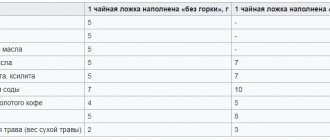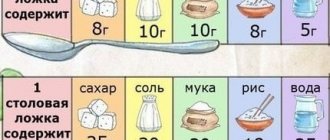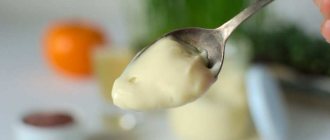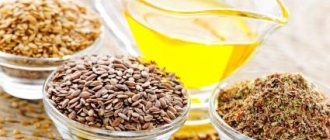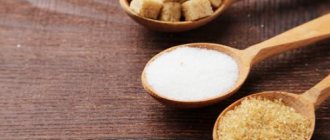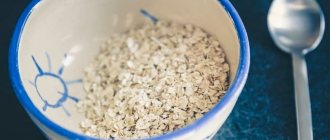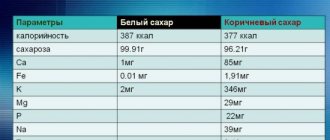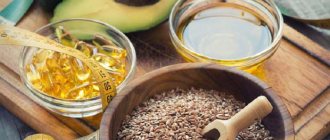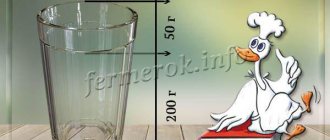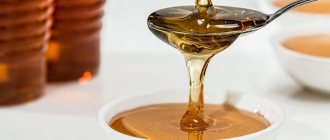Cooks from all over the world use a wide variety of tools to prepare food. There are materials that no kitchen or dining room can do without. These include spoons. In home kitchens the most popular is the tablespoon followed by the teaspoon, how many grams does this tool hold? Housewives ask this question because they often use this tool as a measuring device when cooking. The answer to this question depends on the type of ingredient being measured and its physical properties. This article provides guidelines for the content of products in this tool.
How much does a spoon weigh
How much does a teaspoon itself weigh? Depending on the material of manufacture, the length and shape of the handle, this figure ranges from 20 to 60 g. However, the size of the tool itself does not play a big role. Much more important is how many different ingredients a given spoon can hold.
Knowing how many grams are in a teaspoon helps housewives prepare food. Often recipes only indicate the weight of the ingredients. Without a kitchen scale, it is very difficult to determine by eye the amount of different ingredients indicated by such numbers. In view of this, it is recommended that all housewives have accurate electronic scales in the kitchen that show the mass of an ingredient with an accuracy of 1 g.
Electronic kitchen scales are not recommended for weighing non-food products, as washing the device is problematic. There is a high probability of damage to the mechanism and water getting into the electronic device. For careful use, it is recommended to tart the paper or plate before starting, and then pour the ingredients into it for weighing.
Unique product
Honey is widely used in many areas of life. Thus, it is considered indispensable in alternative medicine: it helps improve immunity, and is an integral component of many home-prepared medicines. In addition, honey is simply necessary for girls who adhere to different diets. When consumed, the body receives more useful substances, which are so lacking especially in the spring.
There is no need to talk about cooking. After all, honey can be found in every third dessert recipe. When preparing dishes, grams of food are often indicated and it is not written how much it is in volume, and vice versa. But it’s so hard to determine by eye: how many grams of honey are in a tablespoon? This creates a lot of inconvenience for housewives, because not everyone has the opportunity to purchase kitchen scales.
The situation is the same with other products: a tablespoon of sugar, a tablespoon of sunflower oil, a tablespoon of honey - you can find out how many grams these products weigh by reading the next paragraph. With the help of such a “cheat sheet,” housewives will be able to cook without problems, because it lists the most popular products.
So, how many grams of honey and other products are in a tablespoon?
- Sugar – 20 g.
- Powdered sugar – 25 g.
- Salt – 20 g.
- Soda – 23 g.
- Dry yeast – 11 g.
- Honey – 22 g.
- Cinnamon – 15 g.
- Ground coffee – 18 g.
- Granulated gelatin – 15 g.
- Cocoa – 25 g.
- Citric acid in crystals – 16 g.
- Vinegar – 18 g.
- Vegetable oil and melted margarine – 15 g.
- Whole milk – 18 g.
- Sour cream – 20 g.
Rules for measuring without scales
If there are no electronic scales in the kitchen, it is recommended to use improvised means to measure the weight of ingredients. When measuring small quantities, it is recommended to use a teaspoon. However, a teaspoon can contain different quantities and weights of products, depending on their characteristics.
All standards are usually indicated with a small slide. “Small” does not mean any mound that ends up in the spoon after we scoop the product. It is necessary to lightly shake off the contents so that the excess falls off. The resulting quantity should be considered correct for measurement according to the tables described below. Some recipes already contain instructions on how to measure the product using heaped or unheaped teaspoons. If given, these instructions should be followed. Then the recipe will be most accurate.
If we talk about the volume of this instrument, it is traditionally believed that a teaspoon holds 5 ml of liquid. However, this figure may vary depending on the specific instrument. Some spoons have a depression and therefore can hold up to 6 milliliters of liquid, while those that are too flat can only hold 3.5 or 4.
Tea instruments should not be confused with dessert or coffee instruments. Completely different standards are specified for them. Depending on the purpose of the cutlery - teaspoon, table spoon, dessert spoon, its volume is also measured. The weight ratio of a teaspoon to a tablespoon is 1:3. If you don't have one of the above tools, knowing this ratio will help make them interchangeable.
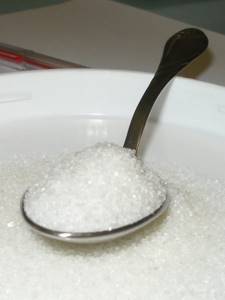
The standard measure is heaped, it needs to be shaken off a little
Grammation in a tablespoon, table
In many recipes, the weight of bulk substances and the volume of liquid substances are indicated in glasses. But sometimes only a small portion of ingredients is needed to create dishes. In this case, the easiest way is to use a tablespoon. A standard cutlery is one whose scoop length is 7 cm and the width of the wide part is 4 cm.
You also need to take into account that sometimes it is taken into account whether the products are collected with or without a slide:
- without a slide - the device is filled to the brim with bulk, powder or liquid;
- with a slide - the maximum amount of bulk or powder has been poured.
To measure the correct amount of any ingredient, it is recommended to use the table data:
| Name of liquid, bulk, powder | Weight in a spoon with a mountain, grams | Weight in spoon, grams |
| Yeast in dry granules | 11 | 8 |
| White sugar | 25 | 20 |
| Coarse rock salt | 30 | 25 |
| Ground salt | 28 | 22 |
| Powdered sugar | 28 | 22 |
| Wheat flour | 30 | 20 |
| Starch | 30 | 20 |
| Cocoa powder | 25 | 20 |
| Water | 18 | |
| Table vinegar | 16 | |
| Milk | 18 | |
| Low-fat sour cream | 25 | |
| Mayonnaise | 20 | |
| Liquid honey | 35 | |
| Melted margarine | 15 |
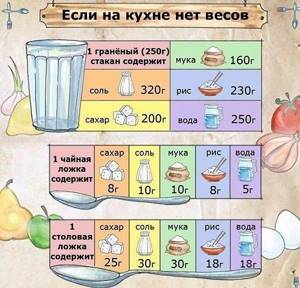
It is most convenient to use a tablespoon when you need to measure a portion of food weighing 18-20 g. It is recommended to use a tea version of the cutlery as a measuring device if a small amount of powder is required - for example, 4 grams or 8 grams.
See also
TOP 3 recipes for preparing spicy tomatoes for the winterRead
How much product does it hold?
By correctly measuring the number of grams inside the container, you can prepare complex and accurate recipes. It is recommended to measure using this tool only if you need to take a minimum amount of product in a dish - up to 10 g. Most often it is necessary to measure spices or products when preparing small portions. When preparing recipes for small children, you will also have to use miniature tools.
When taking measurements, the container must be dry and clean. The most accurate results are obtained when using Soviet instruments. Such tools were used to create the table. In addition, the standards for manufacturing large batches make the instruments of those times identical in weight, volume and depth.
The standards given in the tables below are only valid when using a dry, not wet product. Otherwise, the results shown will be incorrect.
Spices
When measuring spices and comparing them with the data indicated inside the table, use a standard, clean and dry instrument. After the spoon is removed from the container with the product, do not forget to shake it lightly.
| № | Name | Amount per teaspoon (indicated in g) |
| 1 | Cinnamon | 8 |
| 2 | Sugar | 8 |
| 3 | Lemon acid | 8 |
| 4 | Poppy | 5 |
| 5 | Potato starch | 6 |
| 6 | Coarse salt | 10 |
| 7 | Fine salt | 7 |
| 8 | Ground pepper | 6 |
If large quantities of the above products are required, it is recommended to use measuring cups or special measuring tools. If there are none, these tables will be useful. It is enough to know how much of the ingredient is needed; we divide this value by the number of grams in a teaspoon and get the number of teaspoons that need to be added to prepare the dish. Using this algorithm, you can use the tool when working with any products, even with a large number of them.

Liquids
When measuring liquids, it is recommended to use measuring glasses and cups. If you need a small volume, using a teaspoon will be more convenient. Similar numbers may be needed when preparing children's portions, decorating finished products, or when there is no other way to weigh ingredients.
| № | Name | Amount per teaspoon (indicated in g) |
| 1 | Honey | 10 |
| 2 | Tomato paste | 10 |
| 3 | Vinegar | 6 |
| 4 | Jam/jam | 5 |
| 5 | Water | 5 |
| 6 | Sour cream | 6 |
| 7 | Oil | 6 |
Liquid products are mainly collected without a slide. This applies to vinegar, water and liquid honey. When scooping up tomato paste or sour cream, you are allowed to make a small mound. You should not scoop up a lot of butter with a spoon, otherwise the figures in the table will be incorrect. To measure the amount of oil described above, you need to pour a full spoon. Only in this case will the measurement be correct.
Bulk
When measuring large quantities of bulk ingredients, it is recommended to use measuring cups. If a small amount is needed, it is better to use a teaspoon. The contents of the spoon must be shaken off for a more accurate measurement. Its dryness is also important. If you don't have a teaspoon, you can use a tablespoon. In this case, you need to mentally divide its volume into 3 parts and fill only one, which corresponds to the amount of ingredients in a teaspoon.
| № | Name | Amount per teaspoon (indicated in g) |
| 1 | Leaf tea | 2 |
| 2 | Cocoa | 9 |
| 3 | Breadcrumbs | 5 |
| 4 | Coffee | 8 |
| 5 | Flour | 8 |
| 6 | Gelatin powder | 5 |
| 7 | Soda | 7 |
| 8 | Dry yeast | 5 |
The information given regarding gelatin is only valid for the powdered ingredient. Gelatin in plates has different data. Ready-made bulk jellies containing gelatin also differ from the quantity described above. The data is correct only when using 100% powdered gelatin before soaking.
As the information described in the article shows, you can measure the amount of any ingredient using a regular teaspoon. The smaller quantities needed, the easier it is to measure. However, if large quantities of ingredients are required, it is recommended to use other, more suitable measurement methods. If this is not possible, a regular teaspoon will do. Skillful use of this tool makes the work of many housewives easier in all kitchens of the world.

Coffee
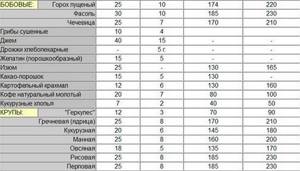
Useful advice
Often, when you get ready to cook something delicious, you discover that not all the necessary ingredients are in the kitchen. If it’s too late to run to the store (the cooking process has begun), then you can replace the missing component with another one that is similar in organoleptic properties.

So, in a tablespoon, as many grams of crystallized honey fit, so much sugar. You can replace 1 liter of whole milk with 100 ml of powdered milk or 400 g of condensed milk. Instead of a kilogram of molasses, you can add 760 g of sugar to baked goods, and instead of 100 g of cognac and rum - 10 g of rum essence.
Recently, more and more often you can find a clause in the recipe with the addition of soy flour. If for some reason the housewife decided not to add it, then such a product can be replaced with regular wheat flour in the same volume.
So, how many grams does a teaspoon of honey weigh? The answer to this question is in the list below.
- Sugar – 5 g.
- Powdered sugar – 8 g.
- Salt – 9 g.
- Soda – 6 g.
- Dry yeast – 2.5 g.
- Honey – 12 g.
- Cinnamon – 8 g.
- Ground coffee – 7 g.
- Granulated gelatin – 8 g.
- Cocoa – 9 g.
- Citric acid in crystals – 7 g.
- Vinegar – 5 g.
- Vegetable oil and melted margarine – 5 g.
- Whole milk – 5 g.
- Sour cream – 9 g.
How many grams in a teaspoon
Tabular data will help to take into account the weight of products measured using a tea product. When selecting bulk or powdered medicines, you need to take into account that the product can be poured with or without a slide.
| Substance name | Weight in grams | |
| filling to the maximum | no slide | |
| Soda | 10 | 7 |
| Finely ground salt | 10 | 7 |
| Powdered sugar | 10 | 7 |
| Rock salt | 12 | 8 |
| Sugar | 8 | 5 |
| Granulated yeast | 3 | 2,5 |
| Wheat flour | 12 | 9 |
| Water | 5 | |
| Table vinegar | 4 | |
| Milk | 5 | |
| Vegetable oil | 4 | |
| Melted margarine | 4 | |
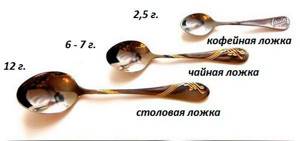
It is most convenient to use a tea device when selecting spices. 1 teaspoon contains 2-3 g of dry herbs. These ingredients must be used carefully, especially when canning.
Expert opinion
Zarechny Maxim Valerievich
Agronomist with 12 years of experience. Our best country expert.
Ask a Question
Because some spices can give a dish a special flavor (bitter, tart, spicy), while others can change the consistency of the finished product.


